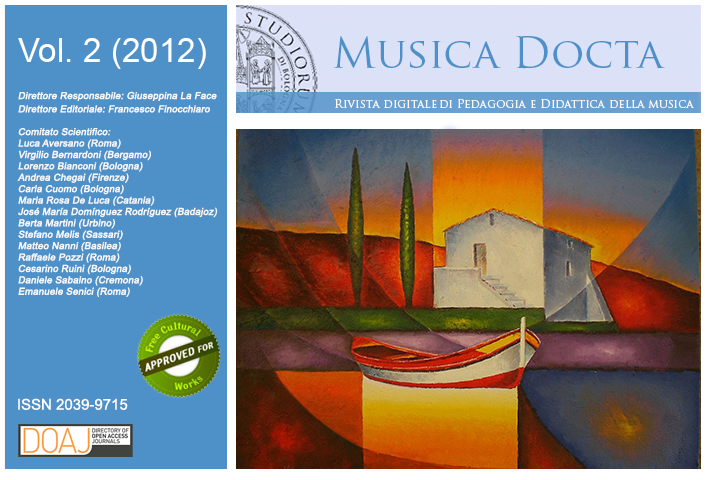Il duetto nell'opera dell'Ottocento: forma e dramma
DOI:
https://doi.org/10.6092/issn.2039-9715/3227Keywords:
duetto, solita forma, morfologia, convenzione, drammaturgiaAbstract
Il duetto e la sua particolare morfologia sono meccanismi drammatici essenziali alla comprensione dell’opera italiana dell’Ottocento. Rientrano fra quei saperi saperi essenziali che ogni docente di musica e ogni studente (diciamo a livello secondario e universitario) deve poter possedere. Questo saggio si pone come un sintetico percorso di scoperta e conoscenza di uno dei congegni drammatico-musicali di base del duetto ottocentesco, la cosiddetta ‘solita forma’, indagata nelle sue varie declinazioni e in senso anche cronologico, attraverso l’esame di alcuni brani esemplificativi, dal Tancredi di Rossini (1813) fino all’Aida di Verdi (1871), e può valere anche come un ideale percorso didattico d’ascolto.
The duet and its particular morphology are essential for understanding the dramatic mechanisms of nineteenth-century Italian opera. They are amongst those essential knowledges that every music teacher and student (at secondary school and university level) must possess. This paper stands as a discovery journey into one of the fundamental dramatic-musical devices of ninetheenth-century opera duet, the so called ‘solita forma’. It is explored chronologically and in its various forms by examining some exemplary pieces, from Rossini’s Tancredi (1813) to Verdi’s Aida (1871). This analysis can also be of value as a listening didactic unit.
Downloads
Published
How to Cite
Issue
Section
License
Copyright (c) 2012 Giorgio Pagannone
The copyrights of all the texts on this journal belong to the respective authors without restrictions.
This journal is licensed under a Creative Commons Attribution Share-Alike 4.0 International License (full legal code).
See also our Open Access Policy.
Metadata
All the metadata of the published material is released in the public domain and may be used by anyone free of charge. This includes references.
Metadata — including references — may be re-used in any medium without prior permission for both not-for-profit and for-profit purposes. We kindly ask users to provide a link to the original metadata record.






